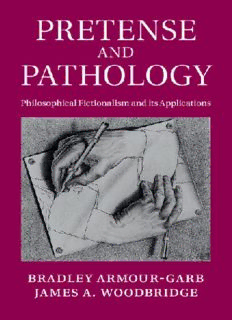
Pretense and Pathology: Philosophical Fictionalism and its Applications PDF
Preview Pretense and Pathology: Philosophical Fictionalism and its Applications
Pretense and Pathology In this book, Bradley Armour-Garb and James A. Woodbridge distinguish various species of fictionalism, locating and defending their own version ofphilosophicalfictionalism.Addressingsemanticandphilosophicalpuzzles thatarise fromordinary language, theyconsider suchissuesas the problem of non-being, plural identity claims, mental-attitude ascriptions, meaning attributions,andtruth-talk.Theyconsider“deflationismabouttruth,”explain- ingwhydeflationistsshouldbefictionalists,andshowhowtheirphilosoph- ical fictionalist account of truth-talk underwrites a dissolution of the Liar Paradox and its kin. They further explore the semantic notions of reference and predicate-satisfaction, showing how philosophical fictionalism can also resolve puzzles that these notions appear to present. Their critical examin- ationoffictionalistapproachesinphilosophy,togetherwiththedevelopment and application of their own brand of philosophical fictionalism, will be of greatinteresttoscholarsandupper-levelstudentsofphilosophyoflanguage, metaphysics, philosophical logic, philosophy of mind, epistemology, and linguistics. bradley armour-garb is Associate Professor of Philosophy at the UniversityatAlbany-SUNYandaFellowofWolfsonCollegeattheUniver- sityofOxford.Heisco-editorofandacontributortoseveralbooks,including TheLawofNon-Contradiction:NewPhilosophicalEssays(2004),Deflation- ismandParadox(2005),andDeflationaryTruth(2005).Heisalsotheeditor ofandacontributortoTheRelevanceoftheLiar(forthcoming). james a. woodbridge isAssociateProfessorofPhilosophyattheUniver- sity of Nevada, Las Vegas. He is the author of “Truth as a Pretense” in FictionalisminMetaphysics(2005).HehasalsopublishedarticleswithBrad- ley Armour-Garb in journals including Noûs, Philosophy and Phenomeno- logicalResearch,Analysis,PhilosophicalStudies,andAustralasianJournal ofPhilosophy,andineditedcollectionssuchasNewWavesinTruth(2010), RecentTrendsinPhilosophicalLogic(2014),andUnifyingthePhilosophyof Truth(2015). Pretense and Pathology Philosophical Fictionalism and its Applications Bradley Armour-Garb and James A. Woodbridge UniversityPrintingHouse,CambridgeCB28BS,UnitedKingdom CambridgeUniversityPressispartoftheUniversityofCambridge. ItfurtherstheUniversity’smissionbydisseminatingknowledgeinthepursuitof education,learning,andresearchatthehighestinternationallevelsofexcellence. www.cambridge.org Informationonthistitle:www.cambridge.org/9781107028272 ©BradleyArmour-GarbandJamesA.Woodbridge2015 Thispublicationisincopyright.Subjecttostatutoryexception andtotheprovisionsofrelevantcollectivelicensingagreements, noreproductionofanypartmaytakeplacewithoutthewritten permissionofCambridgeUniversityPress. Firstpublished2015 AcataloguerecordforthispublicationisavailablefromtheBritishLibrary LibraryofCongressCataloguinginPublicationdata Armour-Garb,BradleyP.,1968-author. Pretenseandpathology:philosophicalfictionalismanditsapplications/Bradley Armour-GarbandJamesA.Woodbridge. pages cm ISBN978-1-107-02827-2(Hardback) 1. Fictions,Theoryof. 2. Philosophy. I. Woodbridge,JamesA.,author. II. Title. BC199.F5A762015 121–dc23 2014042755 ISBN978-1-107-02827-2Hardback CambridgeUniversityPresshasnoresponsibilityforthepersistenceoraccuracyof URLsforexternalorthird-partyinternetwebsitesreferredtointhispublication, anddoesnotguaranteethatanycontentonsuchwebsitesis,orwillremain, accurateorappropriate. An entire mythology is stored within our language. —LudwigWittgenstein,“RemarksonFrazer’sGoldenBough” Contents Preface page ix 1 Philosophical fictionalism 1 1.1 Twospeciesoffictionalism 1 1.2 Someimportantaspectsoffiction(or,aminorforayintophilosophy offiction) 5 1.3 Concernswithcomparativefictionalismquafictionalism 8 1.4 Thecentraltenetsoffictionalism 11 1.5 Fromcomparativefictionalismtophilosophicalfictionalism 18 1.6 Philosophicalfictionalismandotherdistinctionswithinfictionalism 30 2 Semanticpretense-involving fictionalism and existence-talk 39 2.1 Make-believe,representationalaids,andpartiallypretendclaims 39 2.2 Language-worldconnections,long-armconceptualroles,andM-conditions 44 2.3 Typesofpretenseinpartiallypretendclaims 50 2.4 PragmaticPIFanditsproblems 55 2.5 PriorSPIFaccountsandtheEngagementComplaints 60 2.6 OurSPIFaccountofexistence-talk 64 3 Propositional realism and a SPIF account ofproposition-talk 77 3.1 Propositionsandproposition-talk 77 3.2 Benacerraf’schallengesasproblemsforpropositions 79 3.3 OurSPIFaccountofproposition-talk 84 3.4 OurSPIFaccountofproposition-talkandBenacerraf’schallenges 113 4 T-deflationism and a SPIF account of truth-talk 116 4.1 UnderstandingT-deflationism 116 4.2 Frommathematicalfictionalismtotruth-theoreticfictionalism 119 4.3 OurSPIFaccountoftruth-talk 130 4.4 Conclusionsfortruth-talk 150 5 Diagnosing and treating the Liar Paradox andother apparent alethicpathologies 152 5.1 Unearthing(apparent)semanticpathology 152 5.2 Pretenseandmeaninglessness 154 5.3 Meaninglessnessandunderstanding 157 5.4 Meaninglessness,generalization,anddenial 161 5.5 Semanticcharacterizationands-defectiveness 163 vii viii Contents 5.6 S-Defectivenessandliarsentences 165 5.7 Repliestofurtherpotentialrevengeconcerns 168 5.8 Extendedapparentalethicpathology 180 5.9 Diagnosingandtreatingextendedapparentalethicpathology 187 5.10 Closingremarks 190 6 SPIF accounts of reference-talkand predicate-satisfaction-talk and apparent non-alethic semantic pathology 193 6.1 OurSPIFaccountofreference/denotation-talk 193 6.2 OurSPIFaccountofpredicate-satisfaction-talk 202 6.3 Apparentnon-alethicsemanticpathologyrevealed 205 6.4 Diagnosingandtreatingapparentnon-alethicsemanticpathology 210 6.5 Conclusionsforreference/denotation-talkandpredicate-satisfaction-talk 222 7 Extensions and objections 224 7.1 Pluralidentity-talk 224 7.2 M-conditions-talk 241 7.3 Circularityworriesandputativerestrictionsonfictionalism 244 7.4 Achallengetoourdissolutionofapparentsemanticpathology 251 7.5 Concludingremarks 258 Bibliography 259 Index 267
Description: